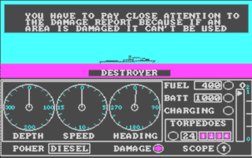Gato (video game)
| GATO | |
|---|---|
 | |
| Developer(s) | Spectrum Holobyte |
| Publisher(s) |
Spectrum Holobyte Atari Corporation |
| Designer(s) | Paul Arlton & Ed Dawson |
| Platform(s) |
MS-DOS (original) Apple IIe, Atari 8-bit, Atari ST, Macintosh |
| Release date(s) |
1984 1987 (Atari 8-bit) |
| Genre(s) | Submarine simulator |
| Mode(s) | Single-player |

GATO is a real-time submarine simulator first published in 1984 by Spectrum HoloByte for MS-DOS. It simulates combat operations aboard the Gato-class submarine USS Growler (SS-215) in the Pacific Theater of World War II. GATO was later ported to the Apple IIe, Atari ST, and Macintosh. In 1987 Atari published a version on cartridge for the Atari 8-bit family, to coincide with the launch of the Atari XEGS.[1]
Description
The player is tasked with chasing Japanese shipping across a 20-sector map while returning for resupply as necessary from a submarine tender. The islands on the map are randomly generated and not based on real-world geography. Combat is conducted using a screen with a view through the periscope and at various gauges and indicators. The game has multiple difficulty levels, the highest of which requires the player to translate mission briefings which are transmitted only as audible Morse Code.
The MS-DOS and Apple IIe versions contain a boss key which replaces the game screen by a spreadsheet.
The timing of the game relied on the computer's CPU clock-speed, rather than the time-and-date clock, making it unplayable as 80286 CPU-based computers came onto the market.
Reception
In 1985, Computer Gaming World praised the game for being simultaneously easy to play and having deep, detailed strategy.[2] 1991 and 1993 surveys in the magazine of strategy and war games, however, gave it one and a half stars out of five, stating that "it was adequate in its time, but not exemplary in any regard".[3][4] Compute! stated that "Gato promises realism, and it delivers ... [it] lives up to its claims".[5] Jerry Pournelle wrote favorably of the game in BYTE, stating that he wished he could slow the game down but "I've certainly wasted enough time with it ... Recommended", and that he preferred the black-and-white Macintosh version to the color IBM PC version.[6]
Production
Marketed by Spectrum HoloByte, Gato had originally been developed by student programmers in Boulder, Colorado.[7]
Gato sold well - being reported in Billboard magazine in June 1985 as coming in at number 6 of a national sample of retail sales and rack sales reports.[8]
References
- ↑ "GATO XE Label". Atari Age.
- ↑ Sipe, Russell (Apr–May 1985), "IBM Goes to War", Computer Gaming World, pp. 24–25
- ↑ Brooks, M. Evan (November 1991). "Computer Strategy and Wargames: The 1900-1950 Epoch / Part I (A-L) of an Annotated Paiktography". Computer Gaming World. p. 138. Retrieved 18 November 2013.
- ↑ Brooks, M. Evan (September 1993). "Brooks' Book of Wargames: 1900-1950, A-P". Computer Gaming World. p. 118. Retrieved 30 July 2014.
- ↑ Williams, Michael B. (November 1985). "Gato For Apple And IBM". Compute! (review). p. 90. Retrieved 30 October 2013.
- ↑ Pournelle, Jerry (September 1985). "PC, Peripherals, Programs, and People". BYTE. p. 347. Retrieved 27 October 2013.
- ↑ "Flight-simulation game is so real that even A.F. wants a piece of action". The Deseret News. 24 January 1988.
- ↑ "3D Living Today - The Top 10". Miami Herald. 29 June 1985.
External links
- GATO at MobyGames
- The MS-DOS version of Gato can be played for free in the browser at the Internet Archive
- Of AJAX, GATO, and Bill Scott